1916 and 2018 World Series – Red Sox v. Dodgers: The 2018 World Series matchup is now set. The Red Sox rolled over Houston in the ALCS, winning four games in a row after losing the first. Los Angeles eliminated Milwaukee in an exciting 7-game series in the NLCS. I will miss Moose and Cain now that Milwaukee is out. The Red Sox won 108 games this season and are the likely favorites over the Dodgers who won 92. But the Dodgers were riddled with injuries during the regular season and may now be peaking. The Series pits the teams with the highest (Boston) and third highest (LA) payrolls, and the games will be played in the oldest (1912) and third oldest (1962) stadiums in major league baseball. For those of you who want to know about #2, the Giants are second in payroll and Wrigley is the second oldest stadium (1914).
These two franchises have met once before in the World Series. In 1916, the Red Sox played the Brooklyn Robins who were named for their revered manager Wilbert Robinson. Brooklyn had other nicknames during the early years, including Trolley Dodgers, a term for pedestrians avoiding street cars in Brooklyn. In 1932, the team formally adopted “Dodgers,” and the name moved with the team to LA in 1958.
In 1916, the Red Sox played in Fenway Park (opened in 1912) and the Dodgers in Ebbets Field (opened in 1913). But the capacity of the other major league stadium in Boston was larger (Braves Field for the NL Braves), so the Red Sox played there for the Series to get more paying customers. The Boston Braves moved to Milwaukee in 1953, and the scoreboard from Braves Field was relocated to Municipal Stadium in Kansas City for the opening season of the A’s in 1955.
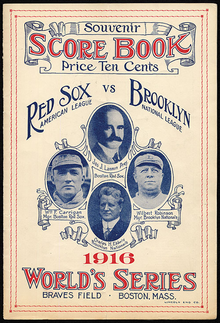
The Red Sox won the 1916 Series four games to one, mostly because of their excellent pitching staff. The best example was a 14-inning complete game victory pitched by Babe Ruth. The top hitter of the Series was outfielder Casey Stengel of the Robins (below, in his checkered uniform).
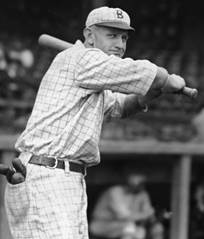
The Red Sox have won eight World Series, starting with the inaugural Series in 1903. They also won in 1912, 1915, 1916 and 1918. They traded Babe Ruth after the 1919 season and suffered the Curse of the Bambino until they won again in 2004 (an 86-year drought). They repeated in 2007 and 2013.
The Dodgers have won six World Series, but did not win their first until 1955. It was the only one while they were in Brooklyn. In Los Angeles, they have won five: 1959, 1963, 1965, 1981 and 1988. The last one is remembered for Kirk Gibson’s walk-off homer, but I’m sure Dodger fans would like some new highlights after 30 years.
As we await the first game tomorrow night (and “Sweet Caroline” in the 8th inning at Fenway), here is a look back at the Series from 50 years ago.
Fifty Years Ago – 1968 World Series – Cardinals v. Tigers: The season of 1968 was the last that had only two teams in the postseason. Each league had 10 teams after expansions in 1961 and 1962, but the postseason was still limited to the winners of the pennants. This would change in 1969 when the leagues divided into east and west divisions to accommodate four new expansion teams (KC, Montreal, San Diego and Seattle).
To tell the story of the 1968 Series, I’m going to quote heavily from Roger Angell’s 1968 New Yorker essay, part of the collection in his book The Summer Game.
The biggest names going into the 1968 Series were Bob Gibson and Denny McLain who won both the Cy Young and MVP in their respective leagues. In the Year of the Pitcher, their superman stats stood out – Gibson’s 1.12 ERA and McLain’s 31 wins.
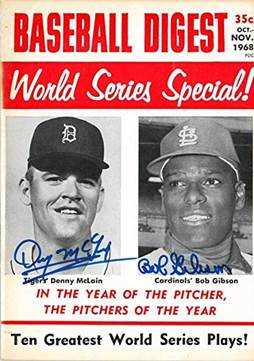
In addition to its pitching stars, St. Louis and Detroit fielded good position players and each team easily won its pennant – the Tigers by 11 games and the Cards by 9. Angell: The teams “were admirably designed for the dimensions of their home parks – the Cardinals, the defending world champions, quick on the bases, brilliant in defense, knowing the subtleties of cutoff, sacrifice, and hit-and-run; the Tigers a band of free-swingers who had bashed a hundred and eighty-one homers and could eschew the delicate touch in the knowledge that their runs would come, probably late and in clusters.”
But the lead story was always the same. Gibson and McLain were poised to face each other in Games 1, 4 and, if necessary, 7. This was not new to Gibson. He had pitched complete-game victories in Games 1, 4 and 7 in the 1967 Series when the Cards beat the Red Sox.
Game 1. The game was all Gibson. As recounted by Angell, Gibson had a weak first inning, but then “settled into his astonishing, flailing delivery, which he finishes with a running lunge toward the first base line.” Meanwhile “McLain , who stands hunchily on the mound, like an Irish middleweight in his ring corner, was mostly high and wild.”
McLain left after 5 innings, trailing 3-0. At the end of the 8th, the score was 4-0 and Gibson had 14 strikeouts. In the 9th, Gibson gave up a single to Mickey Stanley and then faced the heart of the Tiger order. Angell: “Kaline went down swinging at a fast ball, which tied Sandy Koufax’s old Series record of fifteen strikeouts, and then after many foul balls, Gibson got Cash on a beautiful half-speed curve that may have been his best pitch of the game, and Horton on a called third strike that just nicked the back inside corner. Afterward, in the clubhouse, the Tigers sounded like survivors of the Mount Pelee disaster.”
Gibson’s total of 17 strikeouts is still the Series record. If you want more, here is a fun 2013 interview by Bob Costas with Gibson, Al Kaline, Willie Horton and catcher Tim McCarver (4:31).
[October 2 Trivia: Gibson’s new strikeout record occurred on October 2, 1968. It broke the record of 15 set by Sandy Koufax on October 2, 1963…which broke the record of 14 set by Carl Erskine on October 2, 1953.]
Game 2. Angell: “The next day’s baseball was of more human proportions. Detroit’s starter, Mickey Lolich, is a swaybacked, thick-waisted left-hander whose sinker ball becomes more difficult to hit as he grows tired in late innings. This curious propensity may account for his near invulnerability in late-season ball; by midsummer this year he was reduced to bullpen work, but his record after August 6 was ten wins and two losses.”
Lolich played the bulk of his career before the designated hitter rule was established in 1973. So he had 1017 regular season plate appearances in his career and another 20 in the postseason. He hit one home run in all that time, and it was in this game. Lolich cruised to an 8-1 complete game victory.
Game 3. Gibson, McLain and Lolich did not pitch (Ray Washburn of the Cards got the victory). The veteran Al Kaline homered to put the Tigers in front, but Orlando Cepeda and Tim McCarver each hit 3-run homers to lead the Cardinals to 7-4 win. Lou Brock had three singles and stole second each time, giving him six stolen bases for the Series.
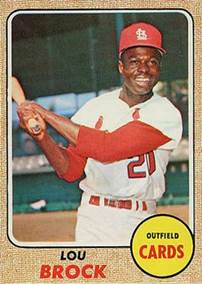
Game 4. Gibson and McLain again squared off. It was no contest. McClain was shelled for six runs and did not return after a 3rd inning rain delay. Gibson pitched another complete game for a 10-1 victory. He also hit a homer. Roger Angell noted that “Lou Brock does not always steal second. He led off the game with a homer, tripled and scored in the fourth…then doubled and stole third in the eighth. It was his seventh stolen base of the Series, tying the record he set last year against Boston.” Not only were the Tigers now down three games to one, but it turned out that McLain had a sore shoulder. Possibly moot if Game 7 never came.
Game 5. Lolich was again pitching for the Tigers, and he quickly gave up three runs to the Cards in the first inning. The Series was looking like it was over. But then the Tigers scored two in the 4th, and per Roger Angell, “From then on, it was a game to treasure – the kind of baseball in which each pitch, each catch, each call becomes an omen.” Al Kaline knocked in the tying and winning runs in the 7th and Lolich completed the game for a 5-3 victory.
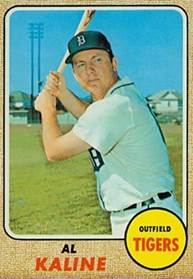
Game 6. Then a little luck for the Tigers. There was a rainout day, so Detroit opted to pitch McLain on two days’ rest – there was no reason to save him for Game 7 if the Tigers might get eliminated. The Tiger hitters made it a no-brainer by scoring 10 runs in the 3rd inning. Angell: “The beneficiary of all this ferocity and good fortune was Denny McLain, suddenly restored to action by a mixed shot of cortisone and Novocaine, and I was glad for him. McLain who is also a professional organist, has an immense appetite for celebrity, a hunger for big money, and hope of a profitable winter career in the night clubs…Now he is off the hook and ready for Vegas.” Final score, 13-1.
Game 7. So the predicted showdown in Game 7 between Gibson and McLain was not to be. Instead, Mickey Lolich, on two days’ rest, faced off against Gibson who had three days’ rest. Each had already won two games in the Series. Both were tired, and it especially showed with Lolich. Angell: “He pitched the first two innings like a man defusing a live bomb, working slowly and unhappily, and studying the problem at length before each new move.” Gibson struck out five of the first nine batters he faced.
The pitchers, tired or not, allowed no runs for six innings. There was a potential threat by the Cardinals in the 6th when two batters singled. But Lolich ended up facing only three batters in the inning. Roger Angell explains:
“Brock led off again in the sixth and singled…he took an extraordinary lead…It was a challenge. Lolich remembered that Brock had succeeded with this identical maneuver in the second game, drawing the throw to first and then beating Cash’s hurried peg down to second. Now, given no other choice, Lolich flipped to Cash. Brock burst away and was in full stride, at least halfway down the line, when Cash was able to wheel and throw. This time, the ball whistled right past Brock’s left ear to Stanley, and Brock was out, by a hair. One out later, Flood got to first on a single and was erased on almost exactly the same pickoff, ending this time in a rundown. Two singles and no double plays, but Lolich somehow set down the side in order.” See the video here (in today’s world of replay, I think Brock may have been safe).
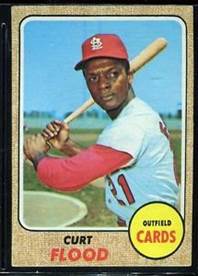
In the top of the 7th, the Tigers put two men on base with two out. Jim Northrup came to the plate and hit a liner deep to center, but well within the range of Gold-Glover Curt Flood. The baseball gods had other ideas. Angell: “Curt Flood started in, reversed abruptly, and then stumbled, kicking up a divot of grass. He recovered in an instant and raced toward the fence, but the ball bounced beyond him, a good four hundred feet out; Northrup had a triple, and two runs were in. Freehan doubled past Brock in left, for the third.” See the video here.
Both pitchers completed the game, each giving up a run in the 9th for a final score of 4-1. The Detroit Tigers were World Champions.
It was still the Year of the Pitcher. In the Series, that pitcher’s name was Mickey Lolich, three-game winner and MVP.
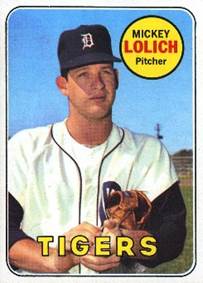
Complete Games – Then and Now: Bob Gibson pitched 17 seasons, all with the Cardinals, and played in the World Series in 1964, 1967 and 1968. Gibson started three games in each, winning seven and losing two. The last eight were complete games. In contrast, there has yet to be a complete game in the 2018 postseason. Don’t hold your breath for one in the World Series.
Yes, pitching strategy has changed. In the 1968 regular season, there were 897 complete games. In 2018, there were 42. In 1968, the top three individual leaders in complete games were Juan Marichal (30), Denny McLain (28) and Bob Gibson (28). In 2018, eight pitchers tied for the top spot – two complete games.
There has been a corresponding drop in shutouts. In 1968, there were 279. In 2018, there were 19, and no pitcher had more than one.
The changes in pitching strategy can also be shown by looking back at that Babe Ruth 14-inning complete game in the 1916 Series. I’m going to compare it to a similar 2-1 game from this year’s postseason.
2018 NLCS – Game 4: The Brewers and Dodgers used a total of 16 pitchers over 13 innings. The Dodgers won 2-1. Game Duration: 5:15.
1916 World Series – Game 2: The Red Sox and the Brooklyn Robins used a total of 2 pitchers over 14 innings. The Red Sox won 2-1. Game Duration: 2:32. The two pitchers hurling complete games were Babe Ruth for the Sox and Sherry Smith for the Robins.
[14-Inning Trivia: The 14-inning game in 1916 is still the record for the longest game by innings in a World Series. It has been tied twice since then. The first was in 2005 in the first-ever World Series game in Texas. The Astros (then in the NL) lost to the White Sox in Game 3 in 14 innings. They also established the record for the longest game by the clock in the World Series. Game Duration: 5:41.
The second 14-inning game is well known to Royals fans. In Game 1 of the 2015 World Series, the Royals were behind 4-3 in the 9th when Alex Gordon tied the game with a dramatic homer. The Royals won in the 14th when Eric Hosmer’s sacrifice fly scored Alcides Escobar. This meant Escobar scored on the last pitch of the game and also the first – he opened the game by hitting the first pitch for an inside-the-park homer. Game Duration: 5:09.]
Lonnie’s Jukebox – Tigers Edition: After the Series, a group called “The Fans” released a record titled “Roly Poly Mickey Lolich.” Known for his girth, Lolich himself once said, “I’m over 200 and somewhere below 300. Weight is always a big deal to everybody, but it’s the arm and not the belly that you pitch with. I’m the roly-poly, I’m the beer belly, but I’m the hero to that guy watching me on TV.” Listen here as the band raps through the Tiger lineup.
Denny McLain followed up on his celebrity year of 31 wins by going on the road as a professional organ player. Just three days after the Series ended, McLain was on the Ed Sullivan show with another special guest, Bob Gibson. Check out Ed’s intro of Gibson – “batting .450 on the gee-tar” – as Bob joins Denny on the stage. Click here (0:60).
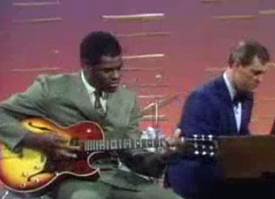
Lonnie’s Jukebox – Star-Spangled Edition: There is a good chance that many Hot Stove readers know about Game 5 of the 1968 Series, but need one more fact to jog your memory – Jose Feliciano sang the National Anthem. His unique version stunned the traditionalists. After all, during the 50 years since the Star-Spangled Banner got its baseball start at the 1918 World Series, the fans had only heard traditional versions. What happened?
The story begins with Ernie Harwell, the beloved play-by-play broadcaster of Tiger baseball for 42 years. Harwell was given the task of lining up the talent for the National Anthem for Games 3, 4 and 5 in Detroit. Harwell recruited Detroit-born singer Margaret Whiting, Motown icon Marvin Gaye and rising young star Jose Feliciano. When Tigers’ general manager saw the list, he was worried about Marvin Gaye. Campbell was not a Motown kind of guy and instructed Harwell that he wanted Gaye to stick to tradition. Both Whiting and Gaye did just that. But then came Game 5.
Jose Feliciano was born in Puerto Rico and was just a boy when he moved to Spanish Harlem in New York. Blind since birth, Feliciano became a singer and virtuoso guitar player. His cover of the Doors’ “Light my Fire” was a big hit in the summer of 1968. At Game 5, he and his guide dog Trudy were escorted to center field by Ernie Harwell. Strumming his acoustic guitar, Feliciano delivered his slow, Latin-jazz performance. The song took less than two minutes, but the controversy lingered for years. Among other invectives, some called for his deportation (apparently thinking that Puerto Ricans are less than U.S. citizens).
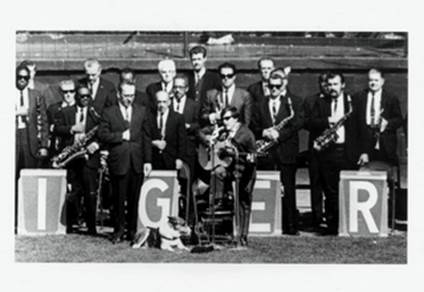
Many comments were negative, but others saw no problem. Even Cardinal teammates had differing opinions. Roger Maris: “I don’t think it was the proper place for that kind of treatment. Maybe I’m a conservative.” Tim McCarver: “Why not that way? People go through a routine when they play the anthem. They stand up and yawn and almost fall asleep. This way, at least they listened.” Bob Gibson has been quoted both ways: the “worst thing” he’d ever heard in his life and “sort of like it.” See for yourself here.
As it turned out, Feliciano opened the door for stylized versions of the anthem. One of the beneficiaries of the trend was Marvin Gaye. Some 15 years after he delivered his “straight” version at the World Series, Gaye blew away the players and fans at the 1983 NBA All-Star Game. He belted out a soulful rendition that you must watch.

Over the years, Feliciano was welcomed to other stadiums and warmly received for his take on the anthem. When the retired Ernie Harwell found that he was dying of cancer, he asked the Tigers to bring Feliciano back for a game in Detroit. They did so for Ernie’s memorial a few days after he died in 2010. Jose sang in the style of his 1968 performance. There were no complaints.
As there are personalized versions of singing the anthem, there are also personalized versions of listening. Feliciano’s appearance at the Series was on October 7, 1968. Nine days later, at the Summer Olympics in Mexico City, U.S. sprinters Tommie Smith (gold) and John Carlos (bronze) won medals in the 200-meter dash. As they stood on the medal podium and the National Anthem played, they raised their black-gloved fists to protest racism and poverty in their home country. The two athletes were kicked out of the Olympics and ostracized by the U.S. sporting establishment. Fast forward to 2016. Several NFL players sat or took a knee during the anthem to protest racial injustice. The primary face has been Colin Kaepernick who arguably has been ostracized by the NFL establishment.
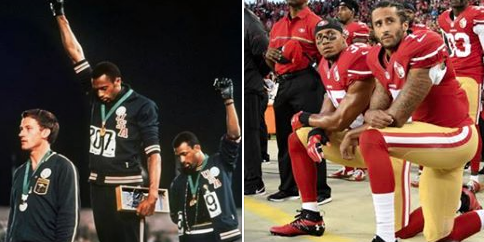
Marvin Gaye’s 1983 NBA performance was used as part of a commercial honoring the 2008 U.S.A. basketball team. The sponsor of the ad was…wait for it…wait for it…Nike! That ad ends with the tagline “Just do it,” as does the Nike ad that just came out featuring Colin Kaepernick. A related print ad with Kaepernick’s photo adds the slogan “Believe in something. Even if it means sacrificing everything.” Smith and Carlos can relate to that. Note that LeBron James is in both video ads (2008 and 2018).
The Star-Spangled beat goes on.